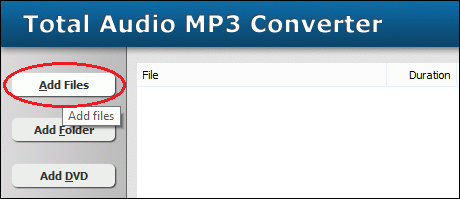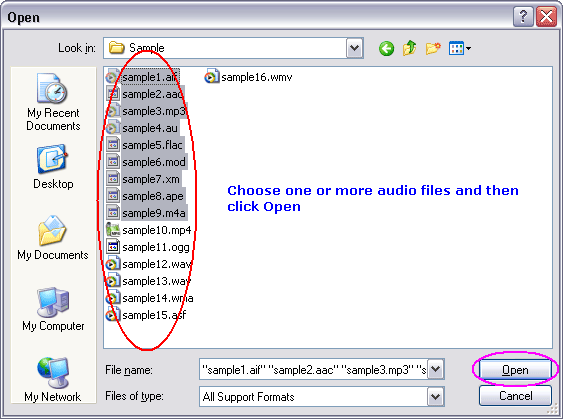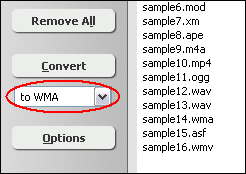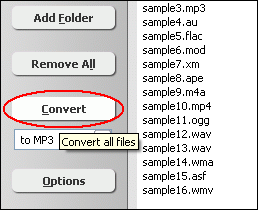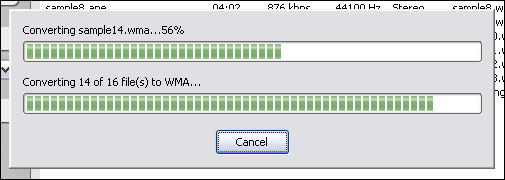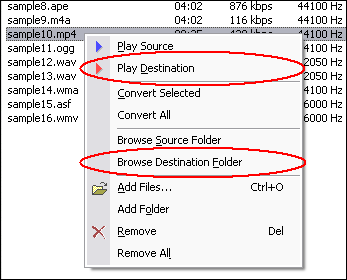ROQ to WMAConvert ROQ to WMA, ROQ to WMA Converter |
 |
| Home | Getting Started | Download | Buy Now! | Screen Shots | FAQ | Support | Contact |
ROQ to WMA Converter converts ROQ to WMA. The software is an ALL-IN-ONE audio converter that supports more than 100 audio and video files. ROQ to WMA Converter supports batch conversion and is full compatible with Vista and Windows 7.
What is ROQ? The format runs at a fixed 30 frames per second with an optional 22050 Hz mono or stereo sound track. Videos may technically be up to 65520 x 65520 pixels with both dimensions divisible by 16 and produce a valid RoQ file, but none of id Software's games will play back a video with dimensions that aren't a power of two, most likely because of OpenGL's texture sizing restrictions. NOTE: It's been reported that movies with dimensions greater than 512 x 512 cause issues in various id Software games. Until this can be positively confirmed or denied it's best to avoid higher resolutions. RoQ is a motion compensating vector quanitizer format, similar to Cinepak, but higher quality due to the use of the ITU-R BT.601 colorspace (the same one used in component video, PAL televisions, JPEG and MPEG), whereas Cinepak uses a low-quality YUV-like colorspace designed for faster decoding that often results in gamut degradation before compression even begins. Because it's a vector quantizer, RoQ files are very fast to decode and very slow to encode. Decoding involves nothing more than converting the colorspace of the codebooks and then copying data, whereas encoding involves using several complicated schemes to produce a "palette" of image fragments that will result in the least degradation. RoQ uses two codebooks per frame, with the second being constructed from pieces of the first, with up to 256 entries each. Due to this, only 1024 new colors can be introduced each frame, severely limiting the color gamut. This could arguably be improved by better predicting which sections will be motion compensated, but doing so is difficult, since codebook entries are generated from non-motion-compensated image sections, but whether or not they'll be used depends on the quality of them compared to motion compensated sections, resulting in a chicken-and-egg problem. This is made worse by the fact that all three major RoQ codecs are single-pass. While the format is limited and much lower quality than MPEG and Indeo Video, it was presumedly preferred by id Software because of the lack of royalties, the lack of patent liability that presents a serious problem with most video formats, and the absence of complex platform-specific APIs. What is WMA? A WMA file is in most circumstances encapsulated, or contained, in the Advanced Systems Format (ASF) container format, featuring a single audio track in one of following codecs: WMA, WMA Pro, WMA Lossless, or WMA Voice. These codecs are technically distinct and mutually incompatible. The ASF container format specifies how metadata about the file is to be encoded, similar to the ID3 tags used by MP3 files. Metadata may include song name, track number, artist name, and also audio normalization values. ROQ to WMA Related Topics: F4V to WMA, FLIC to WMA, GSM to WMA, QCP to WMA, ROQ to WMA, RPL to WMA, MMF to WMA, MP1 to WMA, MPA to WMA, MTS to WMA, NSA to WMA, NSV to WMA, NUT to WMA, OGA to WMA, RM to WMA, RMI to WMA, RMVB to WMA, XVID to WMA, 3GP to WMA, AMR to WMA, AU to WMA, CDA to WMA, FLAC to WMA, IT to WMA, M4A to WMA, M4B to WMA, MPC to WMA, MTM to WMA, OGG to WMA, S3M to WMA, SPX to WMA, TTA to WMA, WV to WMA, MOV to WMA, MPEG to WMA, SWF to WMA, WMA Converter
|
| Home | Getting Started | Download | Buy Now! | Screen Shots | FAQ | Support | Contact | Links |
| Copyright © 2007-2014 Hoo Technologies All rights reserved. Privacy Policy |
